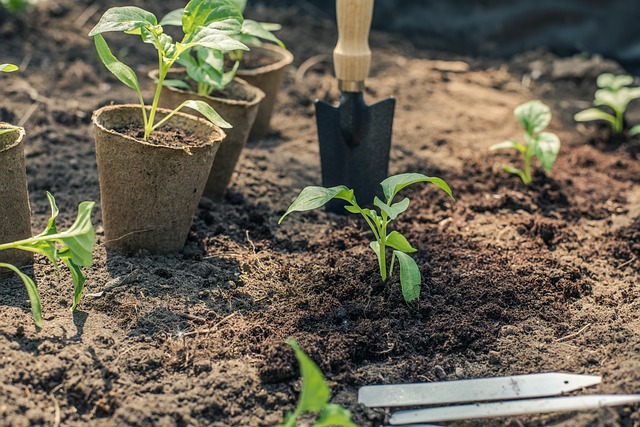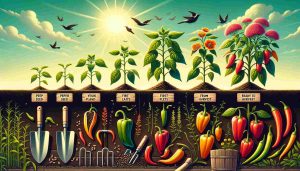If you’re anything like me, you probably find great joy in nurturing plants and watching them grow from tiny seeds into beautiful, fruitful beings. One of my favorite endeavors in gardening has been growing peppers from seeds, and along the way, I’ve encountered many questions about the germination process. Germination is a crucial stage in a plant’s life cycle, and understanding the specific needs of each seed is essential for successful cultivation. Today, I’m diving deep into the world of pepper seeds and exploring a question that’s often asked: “Do pepper seeds need light to germinate?”
No, pepper seeds do not need light to germinate. Pepper seeds are negatively photoblastic, which means they require darkness for successful germination. When kept in a warm and dark environment, the seeds will initiate the germination process and start sprouting. Unlike some other plant seeds that need light exposure to germinate, peppers prefer the absence of light during this crucial phase. To germinate pepper seeds effectively, ensure you provide the optimal temperature (70°F to 85°F or 21°C to 29°C), a well-draining seed starting mix, and consistent moisture. Keep the seeds in a warm, dark location until you see the first signs of sprouting, which typically takes around 7 to 14 days.
Once the pepper seedlings have emerged and developed their true leaves, you can gradually introduce them to light by transitioning them to a well-lit environment, either with natural sunlight or using artificial grow lights. This will support their growth and development into healthy pepper plants that will eventually bear delicious peppers for you to enjoy.
But there’s much more to that and that’s why I wrote this comprehensive guide pepper germination below. Join me as I unravel the science behind germination, discover the role of light in this process, and equip yourself with practical tips to ensure healthy and thriving pepper plants.
Understanding Pepper Seeds Germination
Before I dive into the specific role of light in pepper seed germination, let’s first grasp the fundamentals of germination itself. Germination is a magical process where a seed awakens from its dormant state and begins to sprout into a new plant. As gardeners, we play a pivotal role in creating the ideal conditions for this transformation to occur.
The Science Behind Germination
Germination is a carefully orchestrated symphony of biochemical and physiological processes within the seed. When the right conditions are met, these processes trigger the seed to break its dormancy and initiate growth. The key players in this symphony are water, oxygen, temperature, and in some cases, light.
Key Factors Affecting Germination Success
For successful germination, it’s crucial to consider various factors that impact the seed’s readiness to sprout:
-
- Moisture: Water is the catalyst that activates enzymes within the seed, kickstarting the germination process.
- Oxygen: Just like us, seeds need oxygen to breathe during germination.
- Temperature: Seeds have a preferred temperature range for germination, and maintaining optimal warmth is vital.
- Light: While not all seeds require light to germinate, it plays a significant role for some, including peppers.
The Role of Light in the Germination Process
Light is a fascinating player in germination, and it’s particularly important in the lives of some seeds, including pepper seeds. This phenomenon is known as photoblastism. Depending on the species, seeds can be positively photoblastic, requiring light to germinate, or negatively photoblastic, where darkness is essential.
Now that I’ve laid the groundwork for understanding germination, let’s focus the attention on pepper seeds. Do these vibrant little seeds need light to sprout?
Light and Germination: The Connection
The intriguing connection between light and pepper seed germination! As we delve into this topic, you’ll soon see that pepper seeds have their own unique preferences when it comes to light exposure.
- Photoblastism: How Light Affects Germination Photoblastism is a term that describes a seed’s response to light during germination. Seeds can be classified into two groups based on their photoblastic behavior:
- Positively Photoblastic Seeds: These seeds require exposure to light to trigger germination. When exposed to the right amount of light, they spring into action, bursting with life.
- Negatively Photoblastic Seeds: In contrast, these seeds need darkness for successful germination. When kept in the dark, they happily begin their journey towards becoming sprouts.
- Photoreceptors in Pepper Seeds: Within the pepper seed, tiny photoreceptor cells play a crucial role in sensing light. When these photoreceptors detect light, they transmit signals that kickstart the germination process. For pepper seeds, their photoreceptors are particularly sensitive to certain wavelengths of light, making it essential to provide the right type of illumination.
- The Impact of Light Quality and Intensity on Germination: It’s not just about whether the pepper seeds need light or darkness – the quality and intensity of light matter too! Providing the right kind of light can significantly influence germination success. For instance, fluorescent grow lights or full-spectrum LED lights can mimic natural sunlight and stimulate positive photoblastic seeds to sprout. On the other hand, for negatively photoblastic seeds, keeping them in the dark ensures their journey to growth.
So, how does this information apply to our beloved pepper seeds? Do they need light or darkness to germinate?
Factors Affecting Germination Success
Understanding the various factors that influence germination success is essential for any gardener looking to grow healthy and thriving pepper plants. Let’s explore these factors in detail:
1. Temperature and Humidity
- Optimal Temperature Range: Pepper seeds generally prefer a warm environment for germination, with an ideal temperature range between 70°F to 85°F (21°C to 29°C). Maintaining consistent warmth encourages faster and more uniform germination.
- Managing Humidity Levels: Adequate moisture is crucial during germination. However, excessive moisture can lead to rot or fungal issues. Aim for a consistently moist but not waterlogged seed starting mix.
2. Seed Starting Mix and Containers
- Choosing the Right Seed Starting Mix: A well-draining and sterile seed starting mix provide an ideal medium for pepper seeds to germinate. Avoid using garden soil, as it may contain pathogens harmful to delicate seedlings.
- Selecting Appropriate Containers: Use small containers or seed trays with drainage holes to prevent waterlogging. This helps ensure that excess water drains away, reducing the risk of seedling damping off.
3. Watering Techniques
- Consistent Moisture: During germination, keep the seed starting mix consistently moist, but not soaking wet. Aim to water from the bottom, allowing the mix to wick up moisture as needed.
- Avoid Overwatering and Underwatering: Overwatering can drown the seeds, while underwatering can lead to failed germination. Strike a balance and monitor moisture levels regularly.
4. Light and Darkness Exposure
- Understanding Light Preferences: As we discussed earlier, pepper seeds can be positively or negatively photoblastic, meaning some seeds need light to germinate while others require darkness.
- Providing Appropriate Light: For light-dependent (positive photoblastic) seeds, ensure they receive ample light from a fluorescent grow light or natural sunlight. Keep dark-dependent (negative photoblastic) seeds in a dark, warm place during germination.
5. Seed Viability and Storage
- Assessing Seed Viability: Before planting, check the viability of your pepper seeds. Use the float test or germination test to ensure a high success rate.
- Proper Seed Storage: Store your seeds in a cool, dry place, preferably in airtight containers or seed packets. Proper storage helps maintain their viability for future use.
6. Patience and Observation
- Germination Time: Pepper seeds may take anywhere from 7 to 14 days (or even longer) to germinate, depending on various factors such as seed freshness, temperature, and light conditions. Be patient and resist the urge to disturb the seeds prematurely.
- Observing Seedlings: Once your pepper seeds have germinated, closely observe the seedlings for any signs of legginess, disease, or nutrient deficiencies. Promptly address any issues to ensure healthy plant growth.
Germination Methods for Pepper Seeds
Fantastic! Now that we’ve covered the factors that impact germination success, let’s explore the different methods you can use to germinate your precious pepper seeds. Whether you prefer indoor gardening or want to directly sow them outdoors, there’s a method that suits your preferences:
Indoor Germination
- Setting up a Suitable Indoor Germination Environment:
- Choose a warm location with consistent temperatures within the optimal range (70°F to 85°F or 21°C to 29°C).
- Consider using a seedling heat mat to maintain a stable and warm environment for quicker germination.
- Using Artificial Lights for Optimal Growth:
- For light-dependent pepper seeds, provide 12 to 16 hours of artificial light daily using fluorescent grow lights or full-spectrum LED lights.
- Adjust the light’s height to prevent the seedlings from becoming too leggy.
- Transitioning Seedlings to Outdoor Conditions:
- After the pepper seedlings have developed true leaves and are sturdy enough (usually 6-8 weeks old), begin the hardening-off process.
- Gradually introduce them to outdoor conditions over a week, starting with a few hours in a sheltered spot and gradually increasing exposure to sunlight and wind.
Outdoor Germination
- Direct Sowing Pepper Seeds in the Garden:
- Wait until the danger of frost has passed and the soil has warmed up before direct sowing pepper seeds outdoors.
- Plant the seeds at the appropriate depth as specified on the seed packet, usually around ¼ to ½ inch deep.
- Utilizing Natural Light and Environmental Factors:
- For light-dependent seeds, ensure they receive ample sunlight during the day.
- Provide proper protection from strong winds and extreme weather conditions.
- Protection Against Potential Threats during Outdoor Germination:
- Guard the young seedlings against pests, birds, and other potential threats using barriers or covers.
- Consider using organic pest control methods to keep your pepper plants safe.
Remember, whether you choose indoor or outdoor germination, monitoring the moisture levels, temperature, and light exposure is crucial. Keep a close eye on your pepper seedlings and ensure they receive the care and attention they need.
Troubleshooting Common Germination Issues
While pepper seed germination can be an exciting and rewarding process, sometimes, we encounter challenges along the way. Let’s explore some common germination issues and how to troubleshoot them:
Low Germination Rates
- Seed Quality: Ensure you’re using fresh, viable pepper seeds. Conduct a germination test before planting to check their viability.
- Temperature: Verify that the germination environment maintains the optimal temperature range (70°F to 85°F or 21°C to 29°C) for pepper seeds.
- Moisture: Maintain consistent moisture levels in the seed starting mix without overwatering.
- Light: For light-dependent seeds, ensure they receive enough light from suitable artificial sources or natural sunlight.
Dealing with Leggy Seedlings
- Insufficient Light: Increase the light intensity or duration for seedlings. Adjust the distance between the light source and seedlings to prevent them from reaching for light.
- Temperature Fluctuations: Maintain a stable and warm environment to prevent seedlings from stretching.
- Thinning: If seedlings are overcrowded, thin them out to provide more space and light for the remaining ones.
Preventing Damping Off
- Sterile Seed Starting Mix: Use a sterile seed starting mix to reduce the risk of damping-off disease caused by soilborne pathogens.
- Proper Watering: Avoid overwatering, as excessively moist conditions promote damping off. Water from the bottom or use a spray bottle to moisten the top surface.
Managing Pests and Diseases
- Pest Control: Keep an eye out for pests like aphids, thrips, or fungus gnats. Introduce natural predators or use organic pest control methods to manage infestations.
- Disease Prevention: Provide good air circulation and avoid overcrowding seedlings to prevent the spread of diseases. Consider using a fungicide if necessary.
Supporting Weak Seedlings
- Nutrient Deficiencies: Check for any signs of nutrient deficiencies, such as yellowing leaves or stunted growth. Address deficiencies with appropriate fertilizers or organic supplements.
- Staking: Provide support for weak or tall seedlings using stakes to prevent them from falling over.
Patience and Perseverance
- Germination Time: Some pepper varieties may take longer to germinate than others. Be patient and give them the time they need to sprout.
- Multiple Plantings: If germination rates are low, consider planting a few extra seeds to compensate for potential failures.
Remember, gardening is a journey of learning and adapting. By troubleshooting these common germination issues and making adjustments based on your observations, you’ll increase your chances of success and grow strong, resilient pepper plants that will reward you with a flavorful harvest.
Caring for Germinated Pepper Seedlings
Congratulations on the successful germination of your pepper seeds! Now that your little green sprouts have emerged, it’s time to provide them with the care they need to grow into robust and fruitful pepper plants. Here’s how to nurture your germinated pepper seedlings.
Providing Adequate Light
- Gradual Acclimatization: If you started your seedlings indoors, gradually introduce them to natural sunlight over several days. Begin with a few hours of indirect sunlight and gradually increase the exposure.
- Light Duration: Ensure your pepper seedlings receive 12 to 16 hours of light daily. If using artificial lights, set timers to mimic natural day-night cycles.
Transplanting Seedlings
- True Leaf Development: Wait until your seedlings have developed their true leaves (second set of leaves) before transplanting them into larger containers or the garden.
- Handling Seedlings: Be gentle while transplanting to avoid damaging the delicate roots and stems. Hold the seedlings by the leaves rather than the stems.
Nurturing Healthy Pepper Plants
- Soil Requirements: Plant your seedlings in well-draining, nutrient-rich soil with a pH level between 6.0 and 7.0. Adding organic compost or aged manure can further improve soil fertility.
- Watering: Keep the soil consistently moist, but not waterlogged. Water at the base of the seedlings to prevent wetting the leaves, which can lead to fungal issues.
- Fertilization: Once the seedlings have grown their first true leaves, start feeding them with a balanced liquid fertilizer every 2 to 3 weeks.
- Pruning: Pinch off the top set of leaves when the seedlings are about 6 inches tall to encourage bushier growth and more lateral branches.
- Staking: As the pepper plants grow taller and produce fruits, provide support with stakes or tomato cages to prevent branches from bending or breaking under the weight.
Protecting from Pests and Diseases
- Vigilance: Regularly inspect your pepper plants for any signs of pests or diseases, such as holes in leaves, discoloration, or wilting.
- Natural Pest Control: Introduce beneficial insects like ladybugs or use insecticidal soap as a gentle and natural way to control pests.
- Disease Prevention: Maintain good air circulation, avoid overcrowding, and water at the base of plants to minimize the risk of fungal diseases.
Outdoor Planting Considerations
- Weather Protection: If transplanting seedlings outdoors, monitor the weather and provide temporary protection from extreme heat, cold, or heavy rains.
- Harden-off Process: Harden off your indoor-raised seedlings by gradually exposing them to outdoor conditions over a week to acclimate them to the changes.
By giving your germinated pepper seedlings the proper care and attention they need, you’ll set them on the path to becoming strong and resilient plants that will bear delicious peppers for you to enjoy. Gardening is a labor of love, and your efforts will surely be rewarded with a fruitful and vibrant pepper patch! Happy gardening!
Conclusion
In conclusion, the question of whether pepper seeds need light to germinate is that it depends on the type of seed, as some pepper seeds are positively photoblastic and require light, while others are negatively photoblastic and need darkness for germination. Understanding this critical distinction is vital for successfully growing healthy pepper plants from seed.
To clarify, if you’re growing light-dependent pepper varieties, make sure they receive ample light, either from natural sunlight or artificial grow lights. On the other hand, if you’re working with dark-dependent seeds, keep them in a dark, warm place during the germination process.
Remember to provide your germinated seedlings with proper care, including the right amount of light, temperature, water, and nutrients. Be vigilant against pests and diseases, and ensure good air circulation to promote healthy growth.
Gardening is an enriching experience that nurtures both the body and soul. As you venture into the world of pepper seed germination, embrace the joy of watching life unfold from those tiny seeds and take pride in knowing that you are playing an essential role in this remarkable process.
With your newfound knowledge and dedication, you’re well on your way to cultivating a thriving pepper garden that will reward you with a bounty of delicious peppers to savor and share with friends and family.
Remember, every journey in the garden is a learning experience, and with each season, you’ll refine your skills and deepen your connection with nature.
Happy gardening, and may your pepper garden flourish with abundance and beauty!
Here’s another related question: Do Tomato Seeds Need Light to Germinate?









